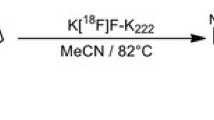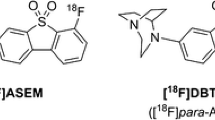Abstract
Purpose
Currently available positron-emitting radiotracers for imaging of the α4β2 subtype of nicotinic acetylcholine receptors (nAChRs) exhibit high and moderate specific binding in the thalamus and extra-thalamic brain regions, respectively. In many neuropsychiatric disorders, α4β2-nAChRs are altered in the extra-thalamic brain regions, but not necessarily in the thalamus. The purpose of this study was to evaluate [18F]XTRA, a new α4β2-nAChR positron emission tomography (PET) radioligand with improved specific binding in extra-thalamic brain regions, in non-human primates.
Procedures
The regional distribution of [18F]XTRA in the brain of Papio anubis baboons was evaluated in baseline and blocking experiments. Various PET modeling procedures were used for determination of volume of distribution (V T), binding potential (BPND), and receptor occupancy. Radiation dosimetry for [18F]XTRA was studied in male CD-1 mice and extrapolated to human dosimetry estimates using OLINDA/EXM software.
Results
[18F]XTRA was synthesized using an automated radiochemistry module with 25 % decay-corrected radiochemical yield. [18F]XTRA readily enters the baboon brain and specifically labels α4β2-nAChRs. Mathematical modeling demonstrates high binding potential values (BPND = 7 and 1.3 in the thalamus and frontal cortex, respectively). A PET scanning time of 90–120 min was sufficient to obtain stable V T values in the extra-thalamic regions. The extrapolated human effective dose was 0.041 mSv/MBq (0.15 Rem/mCi).
Conclusion
[18F]XTRA exhibits improved specific binding in the baboon brain including extra-thalamic regions and it is considered radiologically acceptable for human studies. Further evaluations of [18F]XTRA in human subjects are under way.







Similar content being viewed by others
References
Paterson D, Nordberg A (2000) Neuronal nicotinic receptors in the human brain. Prog Neurobiol 61:75–111
Pimlott SL, Piggott M, Owens J, et al. (2004) Nicotinic acetylcholine receptor distribution in Alzheimer’s disease, dementia with Lewy bodies, Parkinson’s disease, and vascular dementia: in vitro binding study using 5-[125I]-A-85380. Neuropsychopharmacology 29:108–116
Breese CR, Lee MJ, Adams CE, et al. (2000) Abnormal regulation of high affinity nicotinic receptors in subjects with schizophrenia. Neuropsychopharmacology 23:351–364
De Luca V, Voineskos S, Wong G, Kennedy JL (2006) Genetic interaction between alpha4 and beta2 subunits of high affinity nicotinic receptor: analysis in schizophrenia. Exp Brain Res 174:292–296
Whitehouse PJ, Martino AM, Wagster MV, et al. (1988) Reductions in [3H]nicotinic acetylcholine binding in Alzheimer’s disease and Parkinson’s disease: an autoradiographic study. Neurology 38:720–723
Court J, Martin-Ruiz C, Piggott M, et al. (2001) Nicotinic receptor abnormalities in Alzheimer’s disease. Biol Psychiatry 49:175–184
Gotti C, Moretti M, Bohr I, et al. (2006) Selective nicotinic acetylcholine receptor subunit deficits identified in Alzheimer’s disease, Parkinson’s disease and dementia with Lewy bodies by immunoprecipitation. Neurobiol Dis 23:481–489
Teaktong T, Graham AJ, Court JA, et al. (2004) Nicotinic acetylcholine receptor immunohistochemistry in Alzheimer’s disease and dementia with Lewy bodies: differential neuronal and astroglial pathology. J Neurol Sci 225:39–49
Mash DC, Flynn DD, Potter LT (1985) Loss of M2 muscarine receptors in the cerebral cortex in Alzheimer’s disease and experimental cholinergic denervation. Science 228:1115–1117
Meyer PM, Tiepolt S, Barthel H, et al. (2014) Radioligand imaging of alpha4beta2* nicotinic acetylcholine receptors in Alzheimer’s disease and Parkinson’s disease. Q J Nucl Med Mol Imaging
Keller C, Kadir A, Forsberg A, et al. (2011) Long-term effects of galantamine treatment on brain functional activities as measured by PET in Alzheimer’s disease patients. J Alzheimers Dis 24:109–123
Gotti C, Clementi F (2004) Neuronal nicotinic receptors: from structure to pathology. Prog Neurobiol 74:363–396
Gotti C, Moretti M, Gaimarri A, et al. (2007) Heterogeneity and complexity of native brain nicotinic receptors. Biochem Pharmacol 74:1102–1111
Horti AG, Wong DF (2009) Clinical perspective and recent development of PET radioligands for imaging nAChR receptors. PET Clinics 4:89–100
Innis RB, Cunningham VJ, Delforge J, et al. (2007) Consensus nomenclature for in vivo imaging of reversibly binding radioligands. J Cereb Blood Flow Metab 27:1533–1539
Chefer SI, London ED, Koren AO, et al. (2003) Graphical analysis of 2-[18F]FA binding to nicotinic acetylcholine receptors in rhesus monkey brain. Synapse 48:25–34
Bottlaender M, Valette H, Roumenov D, et al. (2003) Biodistribution and radiation dosimetry of 18F-fluoro-A-85380 in healthy volunteers. J Nucl Med 44:596–601
Gao Y, Kuwabara H, Spivak CE, et al. (2008) Discovery of (−)-7-methyl-2-exo-[3′-(6-[18F]fluoropyridin-2-yl)-5′-pyridinyl]-7-azabicyclo[2.2.1]heptane, a radiolabeled antagonist for cerebral nicotinic acetylcholine receptor (Î ± 4Î22-nAChR) with optimal positron emission tomography imaging properties. J Med Chem 51:4751–4764
Wong DF, Kuwabara H, Kim J, et al. (2012) Positron emission tomography (PET) imaging of high-affinity α4β2 nicotinic acetylcholine receptors in humans with [18F]AZAN, a radioligand with optimal brain kinetics. J Nucl Med 54:1308–1314
Kuwabara H, Wong DF, Gao Y, et al. (2012) PET imaging of nicotinic acetylcholine receptors in baboons with 18F-AZAN, a radioligand with improved brain kinetics. J Nucl Med 53:121–129
Rahmim A, Cheng JC, Blinder S, et al. (2005) Statistical dynamic image reconstruction in state-of-the-art high-resolution PET. Phys Med Biol 50:4887–4912
Sossi V, De Jong M, Barker W, et al. (2005) The second generation HRRT: a multi-centre scanner performance investigation [abstract]. Record 4:2195–2199P
Ashburner J, Friston KJ (2003) High-dimensional image warping. In: Frackowiak RSJ, Friston KJ, Frith C, et al. (eds) Human brain function. Academic Press, New York, pp. 673–694
Ashburner J, Friston K (2003) Rigid body registration. In: Frackowiak RSJ, Friston KJ, Frith C, et al. (eds) Human brain function. Academic Press, New York, pp. 635–654
Logan J, Fowler JS, Volkow ND, et al. (1990) Graphical analysis of reversible radioligand binding from time-activity measurements applied to [N-11C-methyl]-(−)-cocaine PET studies in human subjects. J Cereb Blood Flow Metab 10:740–747
Cunningham VJ, Rabiner EA, Slifstein M, et al. (2010) Measuring drug occupancy in the absence of a reference region: the Lassen plot re-visited. J Cereb Blood Flow Metab 30:46–50
Mathews WB, Nakamoto Y, Abraham EH, et al. (2005) Synthesis and biodistribution of [11C]adenosine 5′-monophosphate ([11C]AMP). Mol Imaging Biol 7:203–208
Barrett PH, Bell BM, Cobelli C, et al. (1998) SAAM II: simulation, analysis, and modeling software for tracer and pharmacokinetic studies. Metabolism 47:484–492
Stabin MG, Sparks RB, Crowe E (2005) OLINDA/EXM: the second-generation personal computer software for internal dose assessment in nuclear medicine. J Nucl Med 46:1023–1027
Akaike H (1974) A new look at statistical model identification. IEEE Trans Automat Contr AU- 19:716–722
Marutle A, Warpman U, Bogdanovic N, Nordberg A (1998) Regional distribution of subtypes of nicotinic receptors in human brain and effect of aging studied by (+/−)-[3H]epibatidine. Brain Res 801:143–149
Turner JR, Ortinski PI, Sherrard RM, Kellar KJ (2011) Cerebellar nicotinic cholinergic receptors are intrinsic to the cerebellum: implications for diverse functional roles. Cerebellum 10:748–757
Bois F, Gallezot JD, Zheng MQ, et al. (2015) Evaluation of [(18)F]-(−)-norchlorofluorohomoepibatidine ([(18)F]-(−)-NCFHEB) as a PET radioligand to image the nicotinic acetylcholine receptors in non-human primates. Nucl Med Biol 42:570–577
Kimes AS, Chefer SI, Matochik JA, et al. (2008) Quantification of nicotinic acetylcholine receptors in the human brain with PET: bolus plus infusion administration of 2-[18F]F-A85380. NeuroImage 39:717–727
Brody AL, Mandelkern MA, London ED, et al. (2006) Cigarette smoking saturates brain alpha 4 beta 2 nicotinic acetylcholine receptors. Arch Gen Psychiatry 63:907–915
Chefer SI, Pavlova OA, Zhang Y, et al. (2008) NIDA522131, a new radioligand for imaging extrathalamic nicotinic acetylcholine receptors: in vitro and in vivo evaluation. J Neurochem 104:306–315
Hillmer AT, Wooten DW, Slesarev MS, et al. (2012) PET imaging of alpha4beta2* nicotinic acetylcholine receptors: quantitative analysis of 18F-nifene kinetics in the nonhuman primate. J Nucl Med 53:1471–1480
Hillmer AT, Wooten DW, Moirano J, et al. (2011) Specific alpha4beta2 nicotinic acetylcholine receptor binding of [F-18]nifene in the rhesus monkey. Synapse 65:1309–1318
Pichika R, Easwaramoorthy B, Collins D, et al. (2006) Nicotinic alpha4beta2 receptor imaging agents: part II. Synthesis and biological evaluation of 2-[18F]fluoro-3-[2-((S)-3-pyrrolinyl)methoxy]pyridine (18F-nifene) in rodents and imaging by PET in nonhuman primate. Nucl Med Biol 33:295–304
Hillmer AT, Wooten DW, Slesarev MS, et al. (2013) Measuring alpha4beta2* nicotinic acetylcholine receptor density in vivo with [(18)F]nifene PET in the nonhuman primate. J Cereb Blood Flow Metab 33:1806–1814
Sabri O, Becker GA, Meyer PM, et al. (2015) First-in-human PET quantification study of cerebral alpha4beta2* nicotinic acetylcholine receptors using the novel specific radioligand (−)-[(18)F]Flubatine. NeuroImage 118:199–208
Vaupel DB, Tella SR, Huso DL, et al. (2005) Pharmacological and toxicological evaluation of 2-fluoro-3-(2(S)-azetidinylmethoxy)pyridine (2-F-A-85380), a ligand for imaging cerebral nicotinic acetylcholine receptors with positron emission tomography. J Pharmacol Exp Ther 312:355–365
Acknowledgments
We thank Paige Finley for the help with animal experiments, Karen Edmonds for PET scanner operation, Alimamy Kargbo for HPLC analysis of radiometabolites and Julia Buchanan for editorial help. This research was supported by NIH grant AG037298.
Author information
Authors and Affiliations
Corresponding author
Ethics declarations
Conflict of Interest
The authors declare that they have no conflict of interest.
Electronic supplementary material
ESM 1
(PDF 313 kb)
Rights and permissions
About this article
Cite this article
Kuwabara, H., Gao, Y., Stabin, M. et al. Imaging α4β2 Nicotinic Acetylcholine Receptors (nAChRs) in Baboons with [18F]XTRA, a Radioligand with Improved Specific Binding in Extra-Thalamic Regions. Mol Imaging Biol 19, 280–288 (2017). https://doi.org/10.1007/s11307-016-0999-9
Published:
Issue Date:
DOI: https://doi.org/10.1007/s11307-016-0999-9




